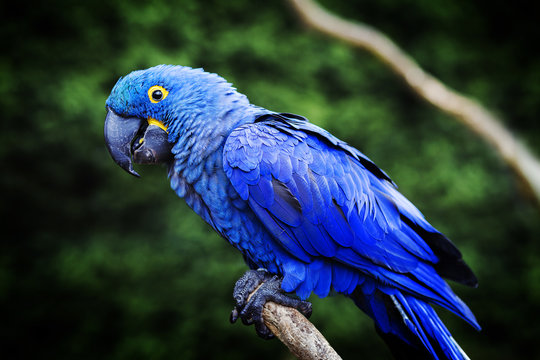ANIMAL: Hyacinth Macaw Andorhynchus hyacinthinus Type of Animal: Parrot Habitat: Swamps, grasslands, forest, rainforest outskirts, humid forest edges, wetlands, savanna, palm stands, caatinga, woodland, scrublands at rainforest outskirts, tall tree/palm areas near rivers, semi-open/open areas near rivers, cattle ranches, grassy marshes, semi-open areas Location(s): C & E Brazil, E Bolivia, & NE Paraguay Appearance: Longest parrot in world & largest macaw, hyacinth blue feathers w/ yellow area near beak, long pointed tail Food/Diet: Fruit, nuts, coconuts, seeds, nectar, berries, legumes, vegetables, leafy greens Status in Wild: Threatened Conservation: Breeding in zoos, aviculture, & wildlife centers. Protections in much of native range. Commercial export banned by CITES (Convention on International Trade in Endangered Species) Appendix I. Captive breeding to reduce demand for wild-caught birds. Hyacinth Macaw project in Brazilian state of Mato Grosso do Sul creating artificial nests in macaw habitat to increase population. Lifestyle: Flocks of 2-26 birds. Break off into monogamous pairs for breeding/nesting season. Additional Info: Called: Male: Cock Female: Hen Young: Chick Group: Flock Weight: Male: 3.2 lbs Female: 2.65 lbs Young: 1-1.3 oz Gestation: 1 month Life Span: 30-50 years in wild, 50-70 years in captivity Height: 3.25 ft Body Length: 3.25 ft Tail Length: 1.5 ft Main predators of adults are raptors, snakes, caimans, tayra, felids, coatis, monkeys, opossums, & rats. Toco toucans, smaller monkeys, skunks, corvids, & false vampire bats prey on chicks. Sexually mature at 2-3 years old. Strong beaks easily crack open nuts. Chicks may stay w/ parents for up to a year. These macaws have a 3.83-4.16 ft wingspan. While increasing, threatened due to pet trade, habitat loss, hunting for feathers/meat, competition for nest sites w/ other animals, climate change, logging, & persecution as crop pests. Females lay 1-3 eggs. Fun Fact(s): One of these birds can sell for $10,000-$12,000. These macaws depend on their chief nest predators, Toco Toucans, in South America’s Pantanal region due to 90% of macaws in region nesting in Manduvi/Panama trees. Toco toucans are important seed dispersers for these trees. Sometimes hybridize w/ other macaw species in captivity. These macaws can sometimes be seen near cattle ranches since many of the palm nuts they eat pass through cattle undigested. They obtain the nuts through cattle poop. Like other macaws, they can be very loud. These macaws tend to be very even-tempered birds & can make decent pets. However, they’re not recommended for 1st time bird owners due to being high maintenance.
